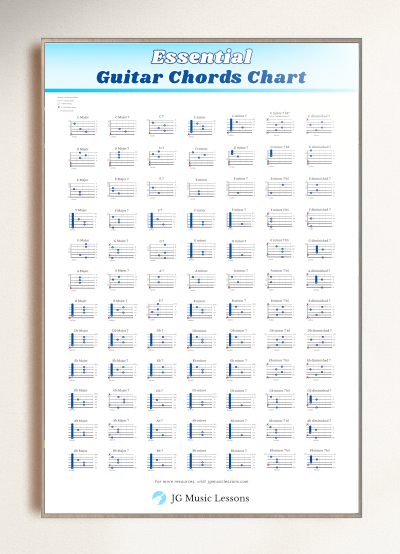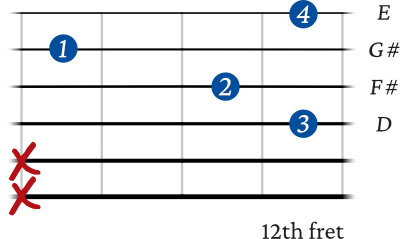If you want to add a jazzy edge to your guitar playing, using 9th chords is a powerful tool that adds a smooth and sophisticated sound to your music. Before learning 9th chords, I recommend first checking out the guide on 7th chords if you don’t know them already.
In this lesson, we’ll break down how the E 9 chord aka E 7 (9) chord works and show you 10 ways to play it on the guitar. Grab your guitar and let’s get started!
E 9 chord theory
Whenever you see a 9 or 7 (9), this implies a Dominant chord with an added 9th interval. This means the chord has the following chord tones: 1, 3, 5, b7, and 9.
For example, the E 7 (9) chord has the notes E, G#, B, D, and F#.
The extension of the 9th note adds a nice tension to your chord as you’ll hear in the examples ahead.
Here’s the formula for the Dominant 7 (9) chord below.

Now that you know what notes belong to the chord structure, let’s look at how to read the chord charts.
How to read the chord charts
For the charts below:
- The top horizontal line of the chord chart represents the high E string and the bottom horizontal line represents the low E string.
- The vertical lines separate each fret.
- The numbers in the blue dots tell you which fingers to use on the fretting hand.
- The letters on the right of the charts tell you what notes you are playing on each string.
- Circles on the left represent open strings.
- Red X means to avoid that string.
You can check this link for more about reading guitar notation symbols.
1. E 9 open chord
Let’s start with this E 9 chord in the 1st position using open strings.

2. E 9 on the 5th string
Here is a classic and simple way to play this 9th chord. The 1st and 6th strings in parentheses are optional additions.

3. E 9 rootless starting – 4th string
This is built from the previous shape which can be played as a rootless voicing and adding a note on the 1st string.

4. E 9 barre chord
This is technically the same as shape 2 but uses a barre to add the note on the first string. This one can be difficult to play if you’ve never tried it. If needed, you can review the other ones and come back to this one.


5. E 9 rootless – 5th string
This chord has a nice sound even as a rootless voicing. You may also know this as a typical G# min 7 b5 chord shape.

6. E 9 6th string variation

7. E 9 rootless variation – 4th string
Here is another rootless variation starting on the 4th string with a cool sound.

8. E 9 3rd inversion
This shape comes from the previous one, except we change the note on the 2nd string.

9. E 9 on the 4th string

10. E 9 4th string variation
Finally, here is one last shape that is less common, starting on the 4th string.

Wrapping Up
Building on the foundation of 7th chords, the E 7 (9) chord incorporates an additional 9th interval on top of the E 7 chord structure. This extended chord adds a smooth and sophisticated sound that’s perfect for jazz, blues, and other genres.
You can play even more variations of this chord by using inversions on different strings. You can see this other lesson to learn how to play chord inversions on guitar.
If you want to take your chords even further, see this lesson on jazz chords on guitar.
📘 Get the free guitar practice guide here!
All the best,
JG Music Lessons
Start Playing Better, Faster
with Pro Membership! ✨
Get the guidance, tools, and support that keep your progress on track:
🏁 Always know what to practice next. Access the full Guitar Learning Roadmap with lessons in sequence.
🎼 Play songs with confidence. Step-by-step lessons of popular, classical pieces and other styles.
📙 Save time and frustration. Clear PDFs and ebooks that save time so you can focus on playing.
🎟️ Get rewarded for consistency. 2 free downloads every month (a $240+ yearly value).
🎁 Keep costs low while you grow. 50% off all charts, tracks, and posters — up to 75% off bundles.
🚫 Stay focused. Ad-free environment keeps you in the zone.
💬 Get help when you need it. Direct member support to keep you on track.

